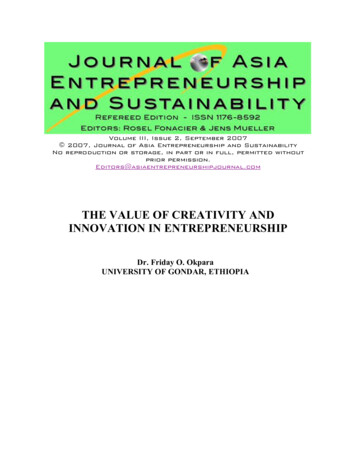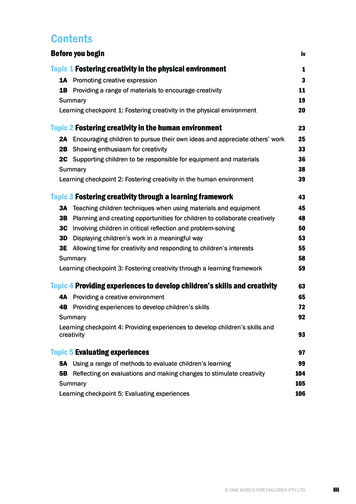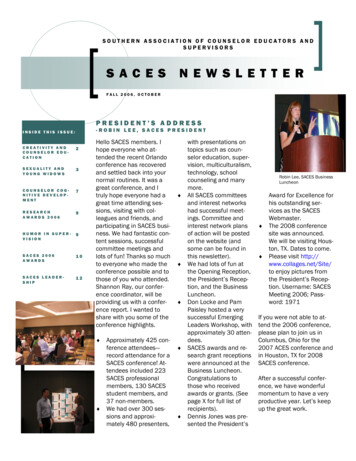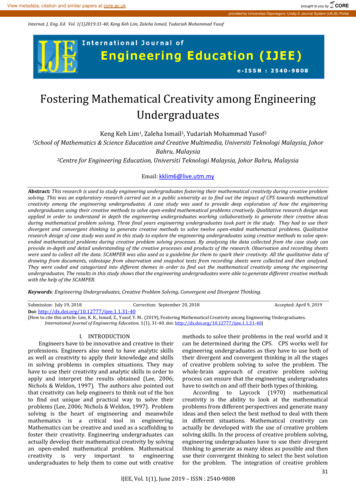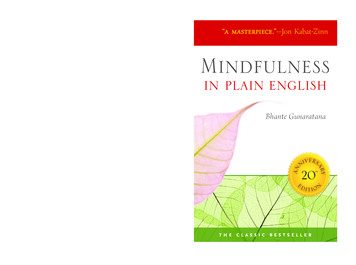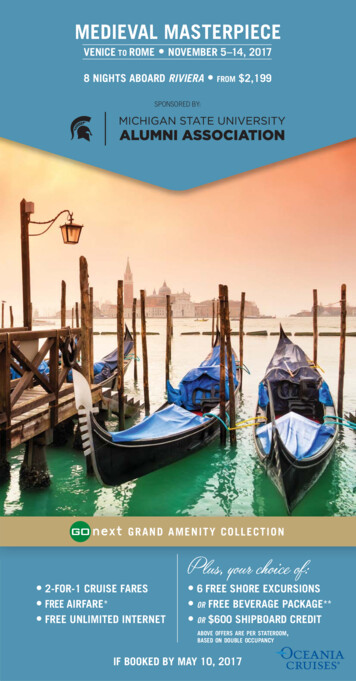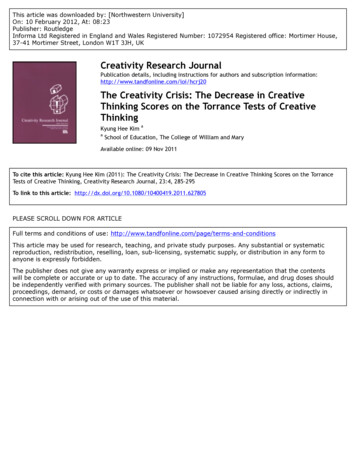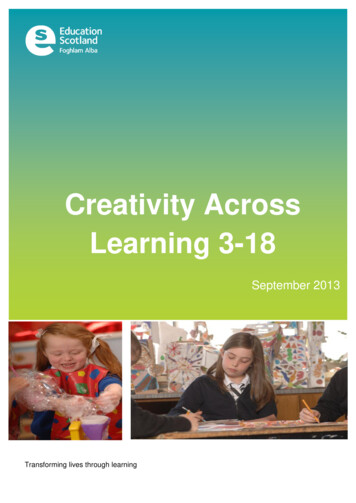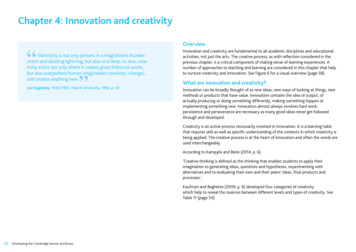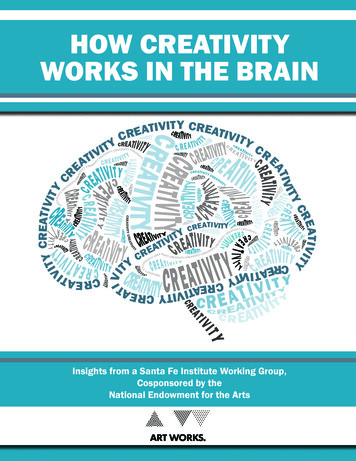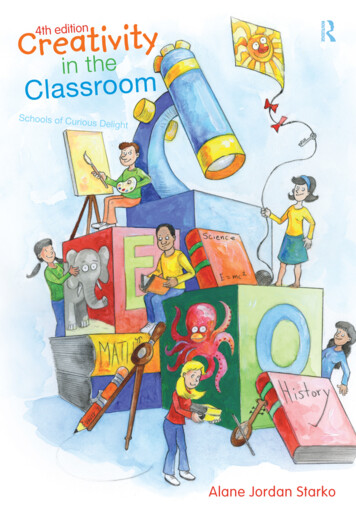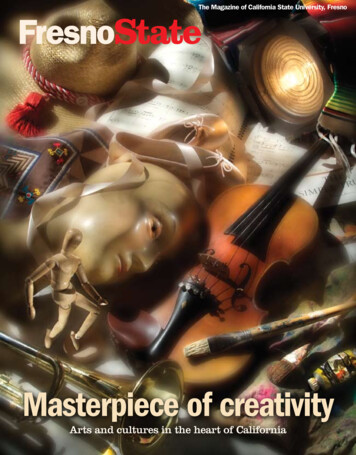
Transcription
The Magazine of California State University, FresnoMasterpiece of creativityArts and cultures in the heart of California
The Magazine of California State University, FresnoFresnoState Magazine is published twiceannually by the Office of University Communicationsat California State University, Fresno.Spring 2006PresidentDr. John D. WeltyVice President of University AdvancementDr. Peter N. SmitsfeaturesAssociate Vice President forUniversity CommunicationsMark AydelotteFresno State: Central California’s creative heart12A world of arts and cultures 12 University programs embrace visual, musical and performance arts while alsoDirector of Publications and New MediaBruce WhitworthDirector of News Services/Magazine EditorShirley Melikian Armbrusteraccenting the multiplicity of cultures in Central California.Unofficial ambassadors19 With a snappy beat and contagious enthusiasm, the 240-member FresnoGraphic Design ConsultantPam ChastainCopyediting ConsultantJacalyn ThorntonState Marching Band lifts the spirits of Bulldog fans.Alumni EditorPeter RobertsonContributing WritersSheri Bohigian, Leslie Cunning, Marni Katz,Dorina K. Lazo, Ron Orozco, Charles Radke, Eli Setencich,Jacalyn Thornton, Curtis Webb, Jan WinslowContributing PhotographersRandy Vaughn-Dotta, Campus Photographer;Khaled Alkotob, Jose Garza, Dave Fultz, Joseph Hollak, KeithKountz, Mark A. Larson, Joe Moore, Kelly Peterson, HenryPlacenti, Joan Sharma, Tom Uribes, Joseph VasquezContributing ArtistDoug HansenPreparing for the future23 A Center for the Music of the Americas and the Central Valley Cultural Heritagecampus notes4Independent Ed.D. in works for 2007; Dr. EricHickey advises French police; Dr. James E. Marshallwins President’s Award of Excellence; StudentRecreation Center opens.Contributing IllustratorScott Severanceresearch and discoveryUniversity Communications Editorial TeamEsther Gonzalez, Priscilla Helling, Angel Langridge,Lanny Larson, Shannon Puphal, Joseph Rachal,April Schulthies, Tom UribesLaboratory skills learned at Fresno State ledJustin Costa to postgraduate cancer research.The opinions expressed in this magazine do notnecessarily reflect official university policy. Letters to theeditor and contributions to the Class Notes section arewelcome; they may be edited for clarity and length. Unlessotherwise noted, articles may be reprinted as long as creditis given. Copyrighted photos may not be reprinted withoutexpress written consent of the photographer. Clippingsand other editorial contributions are appreciated. Allinquiries and comments, including requests for facultycontact information, should be sent to Editor, FresnoStateMagazine, 5241 N. Maple Ave. M/S TA49, Fresno, CA93740-8027.sports newsPhone: 559.278.2795Fax: 559.278.2436On the Web: www.FresnoStateNews.com 2006 California State University, FresnoOn the cover: Poetry, sculpture, painting, music, dramaand dance are represented in objects from Fresno State’sdiverse arts and culture programs. Underscored by Emmys,a Pulitzer Prize and accolades from Broadway and beyond,Fresno State’s students, faculty and alumni form thecreative heart of Central California.Photo by Kelly Petersonp. 12Men’s and women’s tennis teams showcaseAmerican talent and international players.9Institute are among Fresno State’s efforts to reflect the region’s diversity.Classical foundation24 The Classical Studies Program is booming in popularity among students andexperiencing growing national recognition.The written word25 Fresno State’s creative writing and poetry students, faculty and alumnicomprise a writing community that is well known in the publishing world.26 2126Giving and receivingThe new Green V Society is designed to keepBulldog teams competitive.27alumni newsClass notes, milestones and moreCampaign news293030The Spline team learned cutting-edge graphicstechniques at Fresno State, where actressEmily Kuroda honed her craft.386A team of students, staff and community volunteers helpsvictims of Hurricane Katrina.Alumni making a difference in the communityare Jack Kelley and Bill Woodward.28Bulldog chatterp. 610Bronco winery, Radin and Harvey family estate gifts addscholarships and faculty.Stay in touchWe’d like to hear your comments aboutFresnoState Magazine. Please e-mail them tomagazine@csufresno.edu.If you receive more than one copy ofFresnoState Magazine, please pass it alongto a friend of Fresno State!If you would like to support Fresno State,please visit www.SupportFresnoState.comto make a contribution.Tree Portraits40Artist and faculty member Doug Hansen depicts theEucalyptus trees along Chestnut Avenue that businessfaculty member Deborah Kemp calls “sentinels.”
campus notesLook up and you’ll seereminders of distinctiveways Fresno Statecontributes to the quality of life inCentral California. The eye-catchingbanners are displayed throughoutcampus and on surrounding streets.Student biomedical researchefforts get federal supporTAfour-year, 1.3 milliongrant fromthe National Institutesof Health has boostedopportunities forFresno State studentsthrough a MinorityBiomedical ResearchSupport – ResearchInitiative for ScientificEnhancementProgram (RISE forshort).The grant, a first for Fresno State, wasawarded jointly to the College of Scienceand Mathematics and the College ofHealth and Human Services. Biologyprofessor Dr. Alejandro Calderón-Urrea isthe principal investigator.4www.FresnoStateNews.comRandy Vaughn-DottaFresno State-based partnershipbattles obesityO“This agreement is extremelyimportant to Central Californiaresidents who lack adequate accessto doctoral-level education,” FresnoState President John D. Welty says.“This has been keenly felt in thefield of education as schools in thisregion seek highly trained and skilledleaders to meet the challenges oftoday’s classrooms.”Welty pledged to continue workingin cooperation with the Universityof California to offer doctorates inaudiology, physical therapy and otherfields, as called for in the agreement.ne of the nation’s most pressinghealth issues – obesity – is thesubject of a 2.6 million regionalproject based at Fresno State.Hickey connects Franceand Fresno StateObesity is a factor in diabetes and otherchronic conditions. These conditions resultin millions of dollars in health care coststhat could be avoided through preventativemeasures.r. Eric Hickey’s “Frenchconnection” is linkingFresno State with police inParis to help law enforcement developcriminal profiling expertise.DThe Central California Regional ObesityPrevention Program was created by theCentral California Public Health Partnership,a collaboration among regional county healthdirectors and the university. The new projectis funded by a grant from The CaliforniaEndowment to improve social and physicalenvironments for healthy nutrition and physicalactivity through advocacy, policy and systemchange in Central California.Dr. Alonzo Plough, vice president of program,planning, and evaluation for The CaliforniaEndowment, says, “The national epidemic ofobesity is particularly severe in California’sCentral San Joaquin Valley.”Hickey, a professorof criminology withan internationalreputation in hisfield, taught profilingtechniques tocriminologists FabriceTouquet and FlorenceCastande fromFrance last summerto help them teachcriminal profiling,psychocriminologyand forensic sciencesin their country.HickeyHickey, who has trained VIP protectionspecialists around the world in“This legislation marks perhaps the mostsignificant change in the California StateUniversity’s role in the last four decades,”says CSU Chancellor Charles B. Reed.The California State Universitysystem’s origin is in teacherpreparation and one of its coremissions is preparing educationleaders. The new educationalleadership doctorate builds on thatstrength and expertise.profiling and deterring stalkers,has been working with police inParis since 2004 to help establishstandards and techniques forcriminal profiling.The 17.6 million student-funded Student Recreation Center opened inFebruary. The 92,000-square-foot facility is the culmination of six yearsof planning and construction. It features an indoor track, fitness center,aerobic studio and courts for basketball, volleyball, badminton andracquetball. The building includes two educational components, theLeon S. and Pete P. Peters Educational Center and the Lyles Center forInnovation and Entrepreneurship.James Marshall exemplifiesteaching excellenceDr. James E. Marshall, who trainsfuture science teachers and honesthe professional skills of thosealready teaching our K-12th grade students,won the President’s Award of Excellence for2006.Marshall chairs the Department of Curriculumand Instruction, coordinates scienceeducation programs and directs the CentralValley Science Project. He joined the FresnoState faculty in 1990.Dr. Paul Beare, dean of the Kremen Schoolof Education and Human Development,nominated Marshall as an outstandingteacher and scholar devoted to communityservice. The University Advisory Board,composed of community leaders, selected therecipient.The President’s Award of Excellencerecognizes a faculty or staff member whodemonstrates integrity, leadership and acommitment to the university and communityas exemplified by Fresno State PresidentJohn D. Welty.He anticipates that his experienceswill lead to a permanent relationshipthat could result in an exchangeprogram for faculty and students.College of Engineering partnershipspurs oil production, cuts pollutionFresno State is workingwith a NewportBeach company ona revolutionary technology thatcould increase California’sproduction of heavy oil, decreaseair pollution and help achievethe goal of American energyindependence.EDSG Systems developedthe electric downhole steamgeneration technology refinedat Fresno State’s College ofEngineering and the university’sInternational Center for WaterTechnology. On-campus facilitiescertified that the steam system isready for installation in the field.The advanced process createssteam needed for heavy oilproduction from electricity ratherthan surface boilers, which addto air pollution. That steam is lesscostly, more efficient and producesno air emissions.Heavy oil is more abundant inNorth and South America butmore expensive to extract thanlighter crude products, so asystem that cuts costs wouldallow more production.“The clean air approach tosteam generation in heavyoil production underscoreshow universities and theirpartners can make significantcontributions to improving theair quality of the San JoaquinValley,” says Dr. Andrew Hoff,interim dean of the College ofEngineering.Fresno State’s InternationalCenter for Water Technologyalso is trying to reduce waterrequirements for oil field steamproduction to conserve anotherimportant Valley resource.Lanny Larson is a senior writer/editor at Fresno State.Henry PlacentiThe two-year fellowships provideRISE scholars 18,000 (graduates)or 10,000 (undergrads) each year.RISE scholars sign contracts agreeingto participate in research and RISEactivities, complete their B.S. or M.S.degree in two years, and apply to at leastone Ph.D. program.Uc-BasultoStudent Recreation Center adds to campus amenitiesAs part of training Valley’s educationalleaders, Fresno State has offered thedoctorate since 1991 in conjunctionwith the University of California, Davis.The themes also are areas ofemphasis for the university’scomprehensive campaign, the largestfundraising effort in Fresno State’snearly 100-year history. The effortwill support academic excellenceby furthering faculty research,building academic programs andproviding facilities for greater learningopportunities for students.Randy Vaughn-DottaEight Fresno State students were namedto the first RISE cohort: undergraduatesBenjamin Hyatt of Clovis (chemistrymajor), David Sischo of Coarsegold(biology), Sean Thompson of Lemoore(biology), Gerson Uc-Basulto of Salinas(chemistry) and Paula Wright of Fresno(health economics), and graduatestudents Nick Blanchard of Clovis,Natalie Powers of Palmdale and CarlosTristan of Oxnard, all biology majors.Fresno State plans tooffer its first completelyindependent Doctor ofEducation degree in fall 2007 nowthat the state allows California StateUniversity campuses to issue Ed.D.degrees without partnering with aUniversity of California campus.The banners note that Fresno Stateprograms are “Helping grow ahealthier Valley,” “Advancing worldclass agriculture,” “Helping theeconomy grow,” “Celebrating the NewCalifornia’s arts and cultures” and“Educating our children.”Randy Vaughn-DottaThe program isdesigned to enhance the researchenvironment at minority-servinginstitutions and increase the interest,skills and competitiveness of studentsand faculty who pursue biomedicalresearch careers.Independent Ed.D. in worksfor 2007Joseph HollakBanners brighten campusRandy Vaughn-DottaBy Lanny Larson4Marshall (left) with President WeltyFresnoState 5
campus newsBy Bruce WhitworthVolunteers give and receive in Katrina’s aftermathHurricane Katrina.But also remembered by a fewSlidell, La., families for years tocome will be a group of Fresno Statestudents and staff who earlier thisyear went to do what they could tohelp in the face of the overwhelmingdisaster. They cleaned out flooded,mud-filled homes; they piledrubbish head-high; they battledmold and muck, dirt and trash; andeven experienced a hurricane watch.For many of the Fresno Statestudents, this was a first trip out ofCalifornia. There was excitementand there was anticipation of seeingsomewhere new, doing somethingdifferent. But no one anticipatedthe intensity of their feelings whenthey actually witnessed utter chaosand destruction left in the wake ofthe Aug. 29, 2005, visit by HurricaneKatrina to the Gulf Coast.“I felt truly blessed that I couldpour out my heart and soul to helpindividuals who felt that there wasno hope left,” says Leonard Smith,a sophomore mass communicationstudent from Lemoore.Thirty-nine students, three staffmembers and two communityvolunteers left California Jan. 5 for10 days to help victims of HurricaneKatrina. The plan was to workwith Our Lady of Lourdes CatholicChurch and the First Baptist Church6www.FresnoStateNews.comTeam leader David Todd (left), Geri Yang and Johanna Blanks re-roof a home for anelderly homeowner. The team also cleared the house and yard of load after load ofdebris left in the wake of Hurricane Katrina.there just the same. From thehugs and tears of an 80-year-oldhomeowner who had no idea howhe was going to repair his hometo a couple who had lived in theirsfor 40 years. From a 78-year-oldwidow and a 75-year-old widowercame thanks and overwhelminggratitude that will be withmembers of this group for the restof their lives.Piles of rubbish line most of theneighborhood streets in Slidell, La.of Slidell. The churches wereto identify the neediest membersin the community and help theFresno State team with locallogistics – where to stay, whereto obtain building materials andsupplies and dozens of otherdetails necessary for the group tobe effective. But the relationshipbetween students, families andchurches quickly turned into amuch more personal one.“Seeing all the devastation aroundthe town of Slidell and experiencingsuch hospitality and kindness wasway more than anything I expected,”says Katherine Erwin, a freshmanfrom Clovis. “The graciousness thateveryone showed is the one thingthat I will never forget, mainlybecause they had nothing but stillgave anything they had!”Taking a break from their work to insulate and drywall a home for an 88-year-oldresident are (left to right) Bao Xiong, Jennifer Milor, team leader Johanna Blanks,Geri Yang and Margaret Littleton.What they gave was a place for 44people to sleep, eat and clean upafter long, hard days of labor. Theygave food, shelter, support andencouragement, and they gave aliving example of compassion inaction.“My experience in Louisiana wasindescribable,” says Veronica Reyes,a communication major fromFresno. “Knowing that we touchedthe lives of those people in a waywe’ll never understand. What theydon’t know is that they touchedour lives, too, in a way they’ll neverunderstand.”The Fresno State volunteers usedtheir winter break and touchedmany more lives than originallyplanned. The final tally was fourhomes insulated and drywalled; onehome with a new roof; four homesgutted of muddy, moldy rubbish; a20-room elementary school clearedof rubbish, destroyed furniture andcomputers; and countless yardscleaned.“The students did an outstandingjob,”says Dan Westbrook, aninformation technology consultantin the Academic Resources office.“When given a task, they did it.They did not whine or complain.They just did it. It didn’t matterif the job was to pick up dirtymuddy material from a workshopor computer lab or helping cleanout a home, they did it withoutcomplaint,” he says. “It wasamazing to see their dedicationto getting the job done that theycame to do.”But for all the work, all the sacrifice,the rewards were enormous. Nonewas expected, none was needed.None could be photographed norrecorded, but the rewards werePhotos by Bruce WhitworthThat name will forever be linkedwith death and a destructive forcefar beyond description for thosewho haven’t seen its power firsthand. For mile after mile andhome after home, Katrina left nodoubt she had paid the Gulf Coasta visit that will be remembered forgenerations to come.Laura Rodriguez (left) and Miraya Mazquiaranbattle rubbish and a wheelbarrow as theyParticipating in one of the dozens of “mud-outs” the team worked on are (left to right) help clear a 20-room school, cafeteria andClyrin Harper, Flerida Noble, Kelly Gazaway, Sarah Miller and Sarah Coghlan.gymnasium of hurricane debris.And the students worked harderand longer than anticipated. Oneteam worked well after dark andanother worked until just a coupleof hours before it was time to leavefor the airport to come home.“Seeing the students work late intothe night the last few evenings inorder to complete the drywallingof a home was inspiring,”Westbrook says. “They workedtogether as a team to accomplishtheir mission – getting some of thesenior citizens of Slidell back intotheir homes.”The students not only left a legacyof caring, they also brought homeunexpected skills and knowledge.Above: Troy Sherry and Katherine Erwinpause in their work installing drywall.At right: Fresno State staff member DanWestbrook trims a piece of lumber tocomplete a carpentry project.Sponsored Programs. Griffin alsoworks with University Hope, acampus-based volunteer projectthat builds houses for low-incomefamilies in Clovis.“I never thought that I could dodrywall, but when you see allthe grief and destruction thatconsumes that area, you want tohelp, and you learn quickly,” saysLindsay Amaro, a sophomorebusiness major from Selma andvice president of programs forDelta Zeta sorority.“I think the great majority of thestudents, staff and volunteers feltthey made a difference in the livesof some of the residents in Slidell,”says Griffin. “What is somewhatdiscouraging is that there are somany people needing help. Theyhave a long way to go to recover, andsome sections we saw have hardlystarted cleaning up.”“It was by far one of the mostinherently gratifying experiencesof my life. To see the difference inMorgan Zimmerle’s home fromthe first day, when we pulled theceiling out and laid insulation, tothe last day, when we laid the lastpieces of drywall, was quite theexperience. You felt like you reallydid accomplish the trip’s mission,”says Amaro.These families needed helpdesperately, and Fresno Statestudents were there to answerthe call. Tirelessly, selflessly andgenerously. In their 10 days inLouisiana, the team left a legacy ofcaring that will be long rememberedby those whose lives they touched.And they brought home memoriesand a sense of accomplishment thatwill be theirs forever.Staff and students are still raisingfunds to pay for materials andsupplies purchased on the trip.Any donation would be welcome.To donate, please send checksto Hurricane Katrina VolunteerProject, California State University,Fresno, c/o Dan Griffin, 4910 N.Chestnut Ave., Fresno, CA93726-1852.Bruce Whitworth is director ofpublications and new media atFresno State. He was a member of theuniversity team that volunteered inSlidell.The project was put together byDan Griffin, associate directorin the Office of Research andKatrina volunteersFresno State studentsLindsay AmaroJeremy AvilaJohanna BlanksSarah CoghlanJeff DetlefsenJoseph DoKatherine ErwinCamille GastonKelly GazawayBrandon HamiltonClyrin HarperJerry HerMargaret LittletonIssac LopezNicole Rose LopezMai LorJulie MacedoMiraya MazquiaranSarah MillerJennifer MilorIrene MojicaFlerida NobleJennifer PalmerVeronica ReyesShanita RichmondLaura RodriguezTroy SherryLeonard SmithDouglas SulentaMegan SullivanRebecca SussmanAdam TavaresDavid ToddNoemi TorresKimberly TrejoPatrick WallachCasey John WalshBao XiongGeri YangFresno State staffDan GriffinDan WestbrookBruce WhitworthCommunity volunteersDan LundinLisa BewleyFresnoState 7
campus newsresearch and discoveryBy Shirley Melikian ArmbrusterE-wastecollectionis a hitfacility de-manufactures,recycles and crushes cathoderay tubes found in computermonitors, televisions and othervideo equipment.AFresno State started monthlycollection dates in Januaryand since then hundreds ofresidents have brought tens ofthousands of pounds ofe-waste to drop-off locationson campus.Illustration by Scott SeveranceAlmost everybody haselectronic waste: a brokenTV shoved in the corner ofthe garage or old computerscrammed into business-officestorage rooms. When we finallydecide the e-waste as it’s called,must go, we too-often throw it intoa garbage bin – exactly the wrongmove. That sends it to landfills,where decaying circuit boardsand PC screens can leak heavymetals such as mercury, lead andchromium.U.S. homes and businesses dumpas many as 133,000 PCs each day,researchers say. The EnvironmentalProtection Agency estimates thatAmericans discard 2 million tons ofe-waste each year.8www.FresnoStateNews.comCollected e-waste, includingcampus waste, is transportedto ERA’s Fresno facilityfor recycling. ERA’s uniquebar-coded reports andCertificates of AssuredDestruction ensure materialsare disposed of properly,removing liability fromcustomers.Fresno State, which regularlyupgrades electronic equipment toprovide state-of-the-art teachingand learning, generates substantialamounts of e-waste. But in 2005,Fresno State stepped up to aleadership role by offering thecampus and community a way toproperly dispose of e-waste. Theuniversity partnered with ElectronicRecyclers of America to providea convenient e-waste recyclingsolution for the Central Valley.Fresno State gained certification as astate-approved collector for e-waste;it is the only university in Californiaand one of only a few in the nationapproved to collect communitye-waste for recycling.Fresno State President John D. Weltysaid the university is proud to beat the forefront of dealing with animportant environmental concern.He said the campus sought approvalas an e-waste collector as part ofthe university’s commitment toenvironmental responsibility and thepromotion of sustainable practicesin Central California. Fresno Statealso is a Valley leader in promotingclean air, conserving water, andrecycling traditional waste.Electronic Recyclers of America,based in Vista near San Diego,recently opened California’s largestand most advanced e-waste recyclingfacility in southwest Fresno. TheShirley Melikian Armbruster is director of news services at Fresno State.The service also protectspersonal security by thoroughlydestroying discarded hard drives andother data storage devices frequentlyused by identity thieves.The university selected ERA becauseit offers an environmentally safesolution to the increasing problemof electronic waste, said Fresno StateVice President for AdministrationCynthia Teniente-Matson.For details about Fresno State’se-waste recycling program, see:http://ehs.csufresno.edu/CSUFCollector.asp. gfor cancer, which would becomehis master’s thesis.In discussing his research, Costa,27, explains that many of thenewest and most promising cancertherapies target blood vesselsaround a tumor rather than thetumor itself. If you can stop bloodvessels from growing to a tumor,he says, you can starve the tumorof nutrients so it will die. Costainvestigated this idea in relationto a centuries-old Chinese remedyfor cancer using the seeds of a rarepalm tree, Livistona chinensis, theChinese fan palm.Courtesy National Human Genome Research InstituteERA President JohnS. Shegerian, a Fresnobusinessman and FresnoState supporter, is consideredthe state’s leading expert onelectronic waste recycling.Last year, he accompaniedGov. Arnold Schwarzeneggerto China, representing theelectronic waste recyclingindustry.mericans’infatuationwith all thingselectronicseems to have no bounds.Computers with gargantuanmemory? Yes, please. Cellphones that double asoffice assistants? Of course.Tiny MP3 players with 80gigabytes of memory? Cool.TV sets that stretch thewidth of a living room wall?Awesome.Our love affair withelectronics is not a bad thing,but there’s no denying it hasa dark side: As we chase afterthe newer, faster, smalleror bigger, we leave behinda mountain of broken andunwanted hardware. Andthat’s where Fresno Statecomes to the rescue.By Charles RadkeAt home in the labBefore Justin Costabecame a high-caliberscientist, he was aFresno State dropouttending bar in the British VirginIslands.“Then September 11 happened,the tourism industry went southand my job with Club Med fellthrough,” Costa says.Costa returned to Fresno andwas looking for a job when heheard of an entry-level positionin a College of Science andMathematics research lab.“It was the last thing I wanted todo, but it was work and I decidedto take the offer when it came,”he says. His ambivalence quicklychanged to enthusiasm.“It literally took me one minutein the lab to know that researchwas what I wanted to do withthe rest of my life,” Costa says.He’s well on his way to the restof his life, conducting researchat the National Human GenomeResearch Institute and heading toa M.D./Ph.D. program at MountSinai School of Medicine in NewYork City. He will simultaneouslyearn a medical degree and aPh.D. in some area of biomedicalnanotechnologies.It was in the lab at Fresno Statein 2001 that Costa’s life beganto turn around. During hisfirst few months on the job, heread everything he could aboutcancer, molecular biology andbiochemistry. Then he re-enrolledat Fresno State, where Dr. K.P.Wong, dean of the College ofScience and Mathematics, gaveCosta his own project, a “seriouspiece of research with largepotential therapeutic applications.”Costa began researching a remedy“For my thesis, I was able to showthat the seeds make a chemicalthat can stop blood vessels fromforming,” Costa says. “I was ableto look at the chemical in atomicdetail with several analyticalinstruments and offer a model toexplain how the chemical works.”Costa’s findings have directtherapeutic applications to cancerand many other diseases. Thechemical from fan palm seedsoffers a cancer therapy thatcould one day be administered topatients in pill form.These days, Costa works inapplied medical moleculargenetics at the National HumanGenome Research Institute inBethesda, Md.Costa’s findings have directtherapeutic applications to cancerand many other diseases. Thechemical from Chinese fan palmseeds offers a cancer therapy thatcould one day be administered topatients in pill form.In his research, Costa uses manyof the techniques he learned inWong’s lab at Fresno State. “Ihave always thought that cancerand development share commonthemes and are very different waysof looking at similar processes,”he says. As a result, his transitionfrom research in cancer to researchin development was “very easy.”Costa credits Wong, who gave himthe job that changed his life;Dr. Fred Schreiber, who taught thefirst biology class he ever took; andDr. Alejandro Calderón-Urrea, hisfirst graduate professor who gavehim a “ton of encouragement”and helped him get his NationalInstitutes of Health fellowship.Looking to the future, Costa says,“No matter where I end up, I’llbe doing research of one kind oranother.” gCharles Radke is the thesisconsultant in the Division of GraduateStudies at Fresno State.“Basically, I knock out genes inzebrafish one by one,” he says.“Then I look for developmentaldefects in the fish that resemblehuman diseases. We can usethe zebrafish as a model for thehuman disease, and in some cases,map the mutations back onto thehuman genome.”FresnoState 9
campaign newsBy Shannon PuphalDonors make a differenceThree generous giftsto Fresno State willprovide scholarshipsto students in theCollege of Agricultural Sciencesand Technology, President’sHonors Scholars and support achair within the Department ofViticulture and Enology.The contributions are part of theeffort to enhance educational andresearch opportunities offered atFresno State.The Harvey estateThe estate of Dr. John M. and CoraG. Harvey provided 1.5 millionfor scholarships for studentswithin the College of AgriculturalSciences and Technology. It is thelargest cash bequest to the Collegeof Agricultural Sciences andTechnology in Fresno State history.An endowment fund in theHarveys’ names will make availableabout 75,000 per year, withpriority given to graduate students.Dr. Harvey, who earned a biologydegree from Fresno State in 1942,worked for 37 years with theU.S. Department of Agriculture/Agricultural Research Service’sHorticultural Research Laboratoryin Fresno, developing ways toprevent diseases in fruit cropsduring storage and transport tomarkets.Dr. John M. and Cora G. Harvey10www.FresnoStateNews.comThe Heritage SocietyBronco Wine CompanyCora Harvey grew up on a dairyfarm near Hanford, worked manyyears as a bookkeeper and sharedtime away from work with herhusband traveling and gardeningbefore he died in 1996. She diedin
The Magazine of California State University, Fresno Giving and receiving 6 A team of students, staff and community volunteers helps . and Paula Wright of Fresno (health economics), and graduate . Natalie Powers of Palmdale and Carlos Tristan of Oxnard, all biology majors. The two-year fellowships provide RISE scholars 18,000 (graduates) or .
